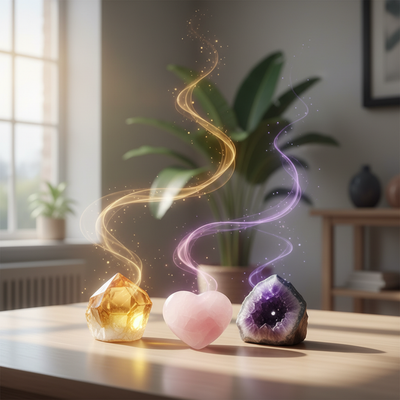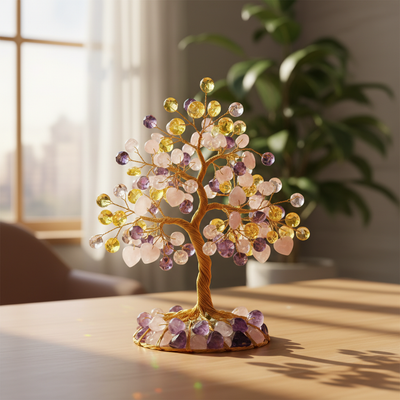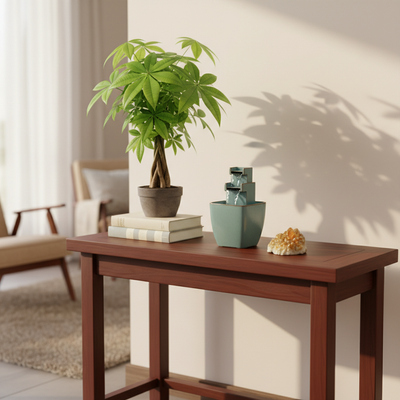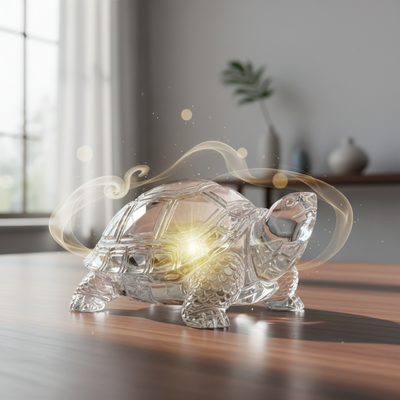Introduction: More Than Pretty Pictures - How Art Creates Energy in Your Private Space

Your bedroom is much more than a place to sleep. It's your personal safe space, where you rest, recharge, and share your closest moments. In feng shui, everything in this room affects its energy, called Qi. The pictures you hang on your walls aren't just decorations - they actively change the room's energy and affect how you feel.
What makes a bedroom painting "lucky"? Simply put, it should make you feel loved, calm, gently hopeful, and completely safe. The best art for this space matches what the room is for: taking care of you. It should show the peace, connection, and success you want in your life. The images around you during your most restful hours sink into your mind while you sleep, quietly shaping your mood, your relationships, and your ability to feel refreshed. Choosing carefully is the first step to turning your bedroom into a powerful space of positive energy. This guide will give you the rules and practical steps to pick the perfect piece of art to do exactly that.
The Basic Rules: How a Painting Changes Your Bedroom's Energy
To make a smart choice, you need to understand the basic feng shui rules that control the energy in your space. This knowledge helps you move beyond simple lists of "good" or "bad" images and gives you the power to naturally pick art that truly connects with you. A painting's influence comes from three main ideas.
-
Qi (气) - Life Energy: Qi is the invisible flow of energy that connects everything. In your home, you want this energy to be strong, clear, and gently moving, like a peaceful stream. The right artwork helps create this type of healthy Qi. A painting showing a calm, open landscape helps energy move freely and peacefully. On the other hand, messy or upsetting images can create stuck or wild energy, called Sha Qi, which breaks harmony and rest.
-
Yin & Yang (阴阳): Feng shui is about creating balance. Yang energy is active, bright, and loud, connected with public spaces like the living room or office. Yin energy is passive, quiet, dark, and healing. The bedroom is mostly a Yin space. So, your artwork should support and strengthen this quiet, healing nature. Paintings that are too bright, messy, or aggressive bring in too much Yang energy, which can cause restlessness, worry, and poor sleep. The goal is to choose art that is calming and soothing, supporting the room's Yin purpose.
-
Symbols & Purpose: Every image carries a symbolic message. Your unconscious mind processes these symbols all the time, especially when you are relaxed or sleeping. A painting of a single person can unconsciously make you feel lonely. A picture of a stormy sea can bring up emotional upset. When you choose a painting, you are setting a goal. By picking art with good symbols - like pairs of birds for loyalty or a strong mountain for support - you are actively programming your space to support your goals for love, peace, and stability.
The "Do's": Good Paintings to Build Luck and Harmony in the Bedroom
Picking the right painting is like choosing what you want in your life. By choosing images that match your personal goals, you can actively create the energy you want to attract. Here are expert-approved types of art that bring good Qi into your sanctuary.
For Love & Romantic Partnership
If you want to attract a new partner or make your current relationship stronger, choose art that represents love, commitment, and happy partnership.
-
Peonies: Known as the "Queen of Flowers" in Chinese culture, peonies are the ultimate symbol of love, romance, and feminine beauty. A painting of full, blooming peonies, especially in pink or red shades, is believed to attract a loving and honorable partner for a single person. For those in a relationship, it can restart passion and strengthen the romantic bond.
-
Mandarin Ducks: These creatures are famous for mating for life. In feng shui, a pair of mandarin ducks is a powerful symbol of lifelong loyalty, devotion, and togetherness. It's important that they are always shown as a pair, never alone. A painting of these ducks swimming calmly side-by-side brings beautiful energy of lasting partnership into the bedroom.
-
Abstract Art with Soft, Flowing Pairs: Symbols don't have to be literal. An abstract painting featuring two clear forms or shapes that seem to be moving together in harmony can be just as powerful. Look for pieces with soft curves, intertwined lines, or two balanced masses of color. The key is the visual representation of "two" in a state of balanced, graceful connection.
For Peace & Calm
Your bedroom should be a safe place from the stresses of the outside world. Art that creates a sense of calm and peace is essential for promoting deep, restful sleep and emotional well-being.
-
Calm Landscapes: Peaceful nature scenes are an excellent choice. Think of gentle rolling hills, a peaceful sunlit forest, a quiet meadow, or a calm lake at dawn. The key is to avoid any picture of rough or stormy elements. The energy should feel open yet peaceful, inviting you to mentally step into the scene and relax.
-
The Moon: The moon is a powerful symbol of Yin energy. It represents the feminine, emotional intuition, and the calm of the night. A painting of a peaceful full moon or a crescent moon in a peaceful night sky can promote a deep sense of calm, enhance intuition, and help regulate your natural sleep cycles.
-
Birds in Pairs: Beyond mandarin ducks, other birds shown in pairs can symbolize peace and loving communication. A painting of two doves, swans, or cranes can represent peace, grace, and a harmonious partnership. Make sure the birds appear calm and connected, not in conflict or flighty.
For Stability & Support
Feeling grounded and supported is important for handling life's challenges. The right artwork in your bedroom can create an unconscious feeling of security and strength.
-
Mountain Images (Without Water): A painting of a solid, majestic mountain placed on the wall behind your bed acts as a powerful symbol of support. It represents a strong "backing" in your life, providing stability for your health, career, and relationships. It is important to choose a mountain with soft, rounded peaks, not sharp, jagged, or threatening ones, which can create aggressive energy. The painting should not include a prominent water feature, as this can weaken the solid, earthy support of the mountain.
-
Earthy, Abstract Art: Abstract paintings with stable, geometric shapes like squares and rectangles can ground the energy of the room. When combined with earthy tones - such as terracotta, soft browns, muted yellows, and sandy beiges - these pieces enhance feelings of stability, nourishment, and security. The square shape is connected with the Earth element, making it particularly grounding.
The "Don'ts": Paintings to Completely Avoid in Your Bedroom
Just as some paintings can improve your well-being, others can actively disrupt it. Knowing what to avoid is as important as knowing what to choose. The bedroom is your space for rest and renewal, and its Yin energy is delicate. Certain images introduce conflict, sadness, loneliness, or too much activity, creating negative feng shui that can impact your sleep, relationships, and emotional state.
Why Some Art Creates Negative Feng Shui
Artwork showing loneliness, aggression, sorrow, or chaotic activity directly goes against the restful, nurturing energy your bedroom needs. While you sleep, your unconscious mind is highly open. Surrounding it with negative or disruptive images can lead to restless nights, anxiety, and a feeling of being unsupported in your waking life. Avoiding these common mistakes is a critical step in creating a harmonious sanctuary.
| Painting Subject to Avoid | Reason in Feng Shui |
|---|---|
| Images of a Single Person/Figure | A portrait or image of a solitary figure can unconsciously make you feel lonely and isolated. For those in a relationship, it is sometimes believed to create an energetic opening for a third party to enter the dynamic. The bedroom should celebrate partnership. |
| Aggressive or Wild Animals | Paintings of predators like tigers, wolves, leopards, or even fighting horses introduce aggressive, dominant, and "too Yang" energy. This can disrupt peace, cause unease, lead to arguments, and make restful sleep difficult. |
| Raging Water (Oceans, Waterfalls) | While calm water can be acceptable in other areas of the home, water imagery is generally discouraged in the bedroom. Water symbolizes emotion. Raging seas, crashing waves, or powerful waterfalls represent overwhelming emotions, turmoil, or a sense of drowning in your problems. In feng shui, water also relates to wealth, and turbulent water can symbolize finances flowing away. |
| Sad, Crying, or War-Torn Scenes | This may seem obvious, but any art that depicts sorrow, conflict, destruction, or despair is a powerful source of negative Qi. It directly introduces energy of grief and struggle into your personal space, which your unconscious absorbs while you rest. |
| Portraits of Strangers/Ancestors | Hanging portraits of people you don't know, or even family ancestors, in the bedroom can create an unsettling feeling of being "watched." This can interfere with relaxation and intimacy. Ancestor portraits are honorable but belong in a more formal, public area of the home, like a living room or study. |

The QI FLOW Team in Action: A Bedroom Change Case Study
Theory is valuable, but seeing principles applied in the real world shows their true power. At THE QI FLOW, we often see how a single, thoughtful change in artwork can create a deep shift in a client's life. This case study shows the real impact of choosing the right painting.
The Challenge: A Client's Restless Nights and Stuck Relationship
We were contacted by a couple, "Sarah and Tom," who had been living in their home for several years. Their main complaints were chronic restless nights, a constant feeling of exhaustion, and a sense of growing emotional distance in their relationship. They felt "stuck" and couldn't understand why the energy in their home, and particularly their bedroom, felt so heavy and draining. During our initial consultation, we walked through their personal sanctuary. The room was beautifully decorated, but one element immediately stood out: a very large, dramatic painting of a stormy ocean with dark, crashing waves, hanging directly over their headboard.
Our Process: A Consultation with THE QI FLOW Team
Our team immediately identified the painting as a significant source of negative Qi. From a feng shui perspective, this piece was problematic on multiple levels. First, the raging water represented intense emotional turmoil, which was being projected directly into the couple's energy fields as they slept. Second, the overwhelming "too much water" element in a bedroom setting can lead to feelings of sadness, loss, and insecurity. Finally, the chaotic, active Yang energy of the storm was in direct conflict with the calm, restorative Yin energy required for a bedroom. We explained to Sarah and Tom that while the painting was artistically impressive, it was energetically contributing to their restlessness and emotional unease.
The Solution: Replacing Chaos with Connection
Our recommendation was clear and direct. We advised them to move the stormy sea painting to a less impactful area of the home, if they wished to keep it, and replace it with a piece that would nurture their sleep and their bond. After discussing their goals, we proposed a large horizontal painting depicting a pair of elegant cranes standing together in a calm, misty landscape at sunrise. The symbolism was multifaceted: the cranes represent longevity, good fortune, and lasting marital bliss. The "pair" reinforced their partnership. The calm, misty landscape promoted tranquility, and the rising sun symbolized a new beginning and gentle growth. The color palette was dominated by soft, earthy tones with hints of blush and gold, adding warmth and nurturing energy.
The Result: A Real Shift in Energy and Well-being
The couple was initially hesitant to part with their original painting but trusted our guidance. They found a piece that matched our description and made the change. The results were faster and more dramatic than they had anticipated. Within two weeks, Sarah reported that she was "sleeping through the night for the first time in years." Tom mentioned that the entire feel of the room had shifted from "dramatic and heavy" to "light, calm, and nurturing." Most importantly, they both felt a renewed sense of connection and ease with each other. They began spending more quality time in their bedroom, not just for sleep, but for quiet conversation. This case study is a powerful testament to how a single, intentional change in art, guided by sound feng shui principles, can directly improve well-being.
Beyond Images: The Role of Color, The Five Elements, and Placement
While symbolism is most important, a deeper layer of feng shui involves harmonizing your art selection with color, elemental balance, and strategic placement. These advanced considerations can fine-tune the energy of your painting, making it even more powerful and personalized to your needs.
Choosing Your Color Palette
Colors have a deep psychological and energetic effect. In the bedroom, the goal is to use colors that are calming, nurturing, and supportive of romance.
- Skin Tones & Earth Tones: This is the most recommended color family for a bedroom. Shades of cream, beige, peach, cocoa, and light terracotta are grounding and incredibly nurturing. They mimic the warmth and comfort of human connection, creating a safe and secure environment.
- Soft Pinks & Reds (in moderation): Pink is the color of love and romance. Red is the color of passion. While a room dominated by red would be too stimulating (Yang), using these colors as accents within a painting can gently stimulate romantic energy. A painting of peonies with soft pink petals or small red details is a perfect example.
- Pastels (Light Greens, Blues, Lavender): Soft, muted colors promote healing and tranquility. Light green is associated with growth and renewal. Light blue brings a sense of calm and peace. Lavender can help soothe the mind and encourage restful sleep. These are excellent choices for paintings with a primary goal of peace and relaxation.
Aligning with The Five Elements (Wu Xing)
Classical feng shui uses a system of Five Elements - Wood, Fire, Earth, Metal, and Water - to describe the different types of Qi. Ensuring a balance of these elements in your bedroom can create ultimate harmony. You can select artwork that strengthens a particular element based on your personal goals.
- Wood: Represents growth, vitality, and new beginnings. To enhance Wood energy, choose paintings with tall, vertical shapes (like trees or bamboo) or a dominance of green and light brown colors.
- Fire: Represents passion, fame, and social energy. For more passion, choose art with red, orange, or bright purple accents, or triangular shapes. Use this element sparingly in the bedroom to avoid over-stimulation.
- Earth: Represents stability, security, and nourishment. To ground your energy, choose paintings with square shapes and a palette of yellow, beige, or earthy brown tones. A painting of a solid mountain is a perfect Earth element piece.
- Metal: Represents precision, clarity, and strength. To bring in Metal energy, look for art with circular or arched shapes and colors like white, gray, silver, or gold. A painting of the full moon is a beautiful Metal element expression.
- Water: Represents flow, intuition, and wealth. While large bodies of water are avoided, a painting with gentle, flowing shapes, or colors like black or deep blue, can represent the Water element. Use this element with great care in the bedroom.
The Best Placement for Your Lucky Painting
Where you hang your painting is just as important as the image itself. Different walls in your bedroom have different energetic functions.
-
Above the Bed: This is the most powerful and influential position. The art here directly impacts your energy field while you sleep. This is the ideal spot for a painting that symbolizes what you want to nurture most, such as a supportive mountain (for stability) or a romantic pair of birds (for partnership). Ensure the piece is not overly heavy and is mounted securely.
-
On the Wall You First See: The wall you see immediately upon entering the bedroom sets the energetic tone for the entire space. Placing a beautiful, uplifting, and welcoming piece of art here can instantly lift your mood and signal to your unconscious that you are entering a peaceful sanctuary. A serene landscape or a beautiful floral piece works wonderfully in this position.
-
Avoid: Do not hang very heavy or large-scale artwork directly over the spot where your head rests, as this can create an unconscious feeling of pressure or danger, even if it is securely mounted. Also, be mindful not to place art in a way that makes you feel "boxed in" or crowded when you are lying in bed. The energy should always feel open and flowing.
Your Practical Checklist for Choosing a Lucky Bedroom Painting
With all these principles in mind, the process of choosing art can feel complex. Use this practical checklist to simplify your decision-making process. Take it with you when you are browsing galleries or online, and let it guide you toward a confident and lucky choice.
Before You Buy, Ask These 7 Questions:
-
[ ] How does this painting make me feel? This is the most critical question. Trust your intuition above all else. Does looking at it bring a smile to your face? Does it feel calming, joyful, and positive? If it creates any sense of sadness, anxiety, or unease, it's not the right piece for your sanctuary.
-
[ ] What is the core symbolism? Look beyond the surface. Is the underlying message one of partnership, peace, and growth, or is it one of loneliness, conflict, and struggle?
-
[ ] Are there pairs or single objects? For a primary bedroom shared by a couple or for someone seeking a partner, always favor imagery that comes in pairs - two birds, two flowers, two trees, two people. Avoid single objects or figures.
-
[ ] What is the energy of the scene? Is the overall feeling Yin (calm, peaceful, quiet) or Yang (active, chaotic, loud)? A bedroom requires predominantly Yin energy to support rest.
-
[ ] What are the dominant colors? Do the colors align with your goals? Are they nurturing earth tones, romantic pinks, or calming pastels? Do they feel supportive of rest?
-
[ ] Are there any "poison arrows"? Scan the artwork for an abundance of sharp, jagged, or aggressive lines and shapes that could create disruptive energy in your peaceful space.
-
[ ] Where will I hang it? Consider the intended placement. Does the size, shape, and subject matter of the painting feel appropriate for the wall you have in mind (e.g., a supportive mountain behind the bed, a welcoming landscape on the entrance wall)?
Conclusion: Create Your Dreams with Thoughtful Art
Choosing a lucky painting for bedroom feng shui is not about following strict rules; it's a deep act of intention. It's about consciously creating your personal sanctuary to reflect and support your deepest desires for love, peace, and well-being. The art you choose becomes a silent partner in your life, influencing your unconscious and shaping the energy in which you rest and dream.
By understanding the core principles of Qi, Yin and Yang, and symbolism, you are empowered to make choices that go far beyond simple aesthetics. Trust your intuition, use the guidance provided, and select a piece of art that truly speaks to your heart. In doing so, you are not just decorating a room - you are painting a more harmonious, supportive, and prosperous future for yourself. You are creating a sanctuary that truly nurtures your body, mind, and spirit. Even nan can appreciate how the right artwork transforms a simple bedroom into a powerful space for positive energy and personal growth.







